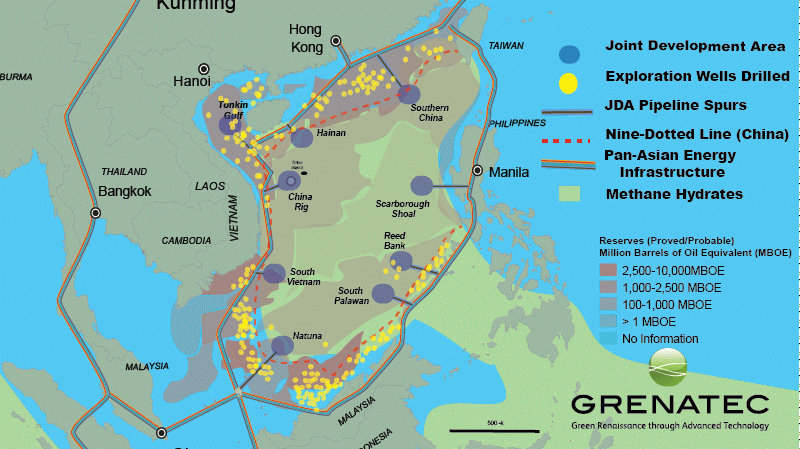China’s Asian Infrastructure Investment Bank’s smartest first loan would be for a Pan-Asian Gas Pipeline connecting Joint Development Areas in the South China Sea.
China’s Asian Infrastructure Investment Bank will make its first loan this year. Nothing would have a greater impact than bankrolling a Pan-Asian Gas Pipeline.
A Pan-Asian Gas Pipeline could connect a series of Joint Development Areas in the South China Sea. These areas would develop the region’s offshore oil, gas, and methane hydrate resources. However, the development of this region is still being held up by territorial uncertainties created by China’s Nine-Dotted Line.
Funding a Pan-Asian Gas Pipeline serving Joint Development Areas represents the most powerful signal China could send of its commitment to regional multilateralism. Markets would do the rest and the timing couldn’t be better. China and the U.S. recently agreed to binding targets for reducing carbon emissions. Moreover, this coming December is the Paris COP21 climate change negotiations, which are globally transformational as the participating nations must agree to binding global carbon cuts.
To date, South China Sea oil and gas exploration and drilling has been largely limited to near shore areas due to uncertainty over China’s maritime claims. Large potential oil and gas deposits still remain unexplored. This is economically inefficient.
A Pan-Asian Gas Pipeline linking Joint Development Areas solves this problem. It marks a first step toward creating an integrated regional energy market. Together with carbon prices, it would be the most powerful tool possible for reorienting the Asian economy to low emission energy using markets, energy fundability and universal access.
Asia is now the world’s largest economic bloc. Reducing destructive climate change largely hinges upon Asia and the energy choices it makes in coming decades. A gas pipeline increases economic growth through expanded energy trade — a massive double win. Both the International Energy Agency and the Asian Development Bank both repeatedly stress the importance to the global economy of deeper Asia energy market integration.
A Pan-Asian Gas Pipeline connecting Joint Development Areas allocated by auction binds China into a universally-beneficial multilateral order. Funded by China’s AIIB with its neighbors as partners, it would represent a regional economic Marshall Plan which could eliminate the major irritations related to China’s expansive territorial claims with its neighbors.
Asia needs trillions of dollars for new infrastructure investment. Half total of this is for energy alone. A number of proto-Pan Asian Gas Pipeline proposals already exist, including the Association of Southeast Asian Nations’ (ASEAN) Trans-ASEAN Gas Pipeline concept. All gas pipeline proposals have the same aim: delivering South China Sea natural gas to Chinese markets.
Given that ASEAN members now comprise half the AIIB’s membership, funding a first project in the ASEAN region is a logical outcome of the AIIB’s creation. It would represent just the first step toward creating a larger regional energy network topology to deliver a broader array of future fuels. That’s because a properly constructed gas pipeline can carry natural gas initially and methane hydrates, bio-energy, hydrogen over the long term. Liquid Natural Gas infrastructure can’t do this. This creates huge, presently undiscounted obsolescence risk to LNG investments in Asia, most demonstrably in Australia’s Queensland.
Pathways laid down by natural gas pipelines enable other infrastructure (such as fiber optic cables and High-Voltage Direct Current power lines) to be added later. Power lines, for instance, can enable offshore wind, wave energy and ocean thermal energy to be developed and delivered. Single-purpose LNG pipelines can’t do this.
The potential for such multi-purpose South China Sea energy infrastructure is readily apparent in ASEAN’s proposed Trans ASEAN Electricity Grid — a companion project to the Trans-ASEAN Gas Pipeline. Laying the foundations for a regional HVDC infrastructure to a regional gas infrastructure could be the AIIB’s second investment.
Offshore energy infrastructure in the South China Sea could become an important source of food for a rising income region. Offshore infrastructure becomes fish aggregation devices. Aquaculture can take root there, providing protein to a hungry region.
With all countries working together toward a common goal, the role of military forces can change from preparing for conflict to ensuring infrastructure security and engaging in humanitarian activities, like providing emergency relief from typhoons, tropical storms and earthquake induced tsunamis. Cooperative militaries also could provide security for the infrastructure.
As at only a few times in history before now — the timing is perfect for this kind of big ‘step change.’ China’s Asian Infrastructure Investment Bank is coming at the very time that the U.S. and China now see eye to eye on reducing bilateral carbon emissions and COP21 meets in Paris.




